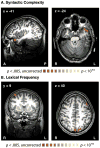Syntactic structure building in the anterior temporal lobe during natural story listening
- PMID: 20472279
- PMCID: PMC2947556
- DOI: 10.1016/j.bandl.2010.04.002
Syntactic structure building in the anterior temporal lobe during natural story listening
Abstract
The neural basis of syntax is a matter of substantial debate. In particular, the inferior frontal gyrus (IFG), or Broca's area, has been prominently linked to syntactic processing, but the anterior temporal lobe has been reported to be activated instead of IFG when manipulating the presence of syntactic structure. These findings are difficult to reconcile because they rely on different laboratory tasks which tap into distinct computations, and may only indirectly relate to natural sentence processing. Here we assessed neural correlates of syntactic structure building in natural language comprehension, free from artificial task demands. Subjects passively listened to Alice in Wonderland during functional magnetic resonance imaging and we correlated brain activity with a word-by-word measure of the amount syntactic structure analyzed. Syntactic structure building correlated with activity in the left anterior temporal lobe, but there was no evidence for a correlation between syntactic structure building and activity in inferior frontal areas. Our results suggest that the anterior temporal lobe computes syntactic structure under natural conditions.
Copyright © 2010 Elsevier Inc. All rights reserved.
Figures





References
-
- Balota DA, Cortese MJ, Sergent-Marshall SD, Spieler DH, Yap MJ. Visual word recognition of single-syllable words. Journal of Experimental Psychology: General. 2004;133(2):283–316. - PubMed
-
- Balota DA, Yap MJ, Cortese MJ, Hutchison KA, Kessler B, Loftis B, et al. The English Lexicon Project. Behavior Research Methods. 2007;39(3):445–459. - PubMed
-
- Ben-Shachar M, Hendler T, Kahn I, Ben-Bashat D, Grodzinsky Y. The Neural Reality of Syntactic Transformations: Evidence from fMRI. Psychological Science. 2003;14(5):433–440. - PubMed
-
- Ben-Shachar M, Palti D, Grodzinsky Y. Neural correlates of syntactic movement: converging evidence from two fMRI experiments. NeuroImage. 2004;21(4):1320–1336. - PubMed
Publication types
MeSH terms
Grants and funding
LinkOut - more resources
Full Text Sources
Molecular Biology Databases
Miscellaneous

